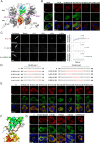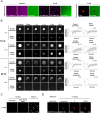Properties of rabies virus phosphoprotein and nucleoprotein biocondensates formed in vitro and in cellulo
- PMID: 36480574
- PMCID: PMC9767369
- DOI: 10.1371/journal.ppat.1011022
Properties of rabies virus phosphoprotein and nucleoprotein biocondensates formed in vitro and in cellulo
Abstract
Rabies virus (RABV) transcription and replication take place within viral factories having liquid properties, called Negri bodies (NBs), that are formed by liquid-liquid phase separation (LLPS). The co-expression of RABV nucleoprotein (N) and phosphoprotein (P) in mammalian cells is sufficient to induce the formation of cytoplasmic biocondensates having properties that are like those of NBs. This cellular minimal system was previously used to identify P domains that are essential for biocondensates formation. Here, we constructed fluorescent versions of N and analyzed by FRAP their dynamics inside the biocondensates formed in this minimal system as well as in NBs of RABV-infected cells using FRAP. The behavior of N appears to be different of P as there was no fluorescence recovery of N proteins after photobleaching. We also identified arginine residues as well as two exposed loops of N involved in condensates formation. Corresponding N mutants exhibited distinct phenotypes in infected cells ranging from co-localization with NBs to exclusion from them associated with a dominant-negative effect on infection. We also demonstrated that in vitro, in crowded environments, purified P as well as purified N0-P complex (in which N is RNA-free) form liquid condensates. We identified P domains required for LLPS in this acellular system. P condensates were shown to associate with liposomes, concentrate RNA, and undergo a liquid-gel transition upon ageing. Conversely, N0-P droplets were disrupted upon incubation with RNA. Taken together, our data emphasize the central role of P in NBs formation and reveal some physicochemical features of P and N0-P droplets relevant for explaining NBs properties such as their envelopment by cellular membranes at late stages of infection and nucleocapsids ejections from the viral factories.
Copyright: © 2022 Nevers et al. This is an open access article distributed under the terms of the Creative Commons Attribution License, which permits unrestricted use, distribution, and reproduction in any medium, provided the original author and source are credited.
Conflict of interest statement
The authors have declared that no competing interests exist.
Figures







Similar articles
-
Structure and Function of Negri Bodies.Adv Exp Med Biol. 2019;1215:111-127. doi: 10.1007/978-3-030-14741-9_6. Adv Exp Med Biol. 2019. PMID: 31317498 Review.
-
Cellular chaperonin CCTγ contributes to rabies virus replication during infection.J Virol. 2013 Jul;87(13):7608-21. doi: 10.1128/JVI.03186-12. Epub 2013 May 1. J Virol. 2013. PMID: 23637400 Free PMC article.
-
Minimal Elements Required for the Formation of Respiratory Syncytial Virus Cytoplasmic Inclusion Bodies In Vivo and In Vitro.mBio. 2020 Sep 22;11(5):e01202-20. doi: 10.1128/mBio.01202-20. mBio. 2020. PMID: 32963000 Free PMC article.
-
Measles Virus Forms Inclusion Bodies with Properties of Liquid Organelles.J Virol. 2019 Oct 15;93(21):e00948-19. doi: 10.1128/JVI.00948-19. Print 2019 Nov 1. J Virol. 2019. PMID: 31375591 Free PMC article.
-
Rabies virus transcription and replication.Adv Virus Res. 2011;79:1-22. doi: 10.1016/B978-0-12-387040-7.00001-9. Adv Virus Res. 2011. PMID: 21601039 Review.
Cited by
-
Dimerization of Rabies Virus Phosphoprotein and Phosphorylation of Its Nucleoprotein Enhance Their Binding Affinity.Viruses. 2024 Nov 4;16(11):1735. doi: 10.3390/v16111735. Viruses. 2024. PMID: 39599850 Free PMC article.
-
Uncovering protein conformational dynamics within two-component viral biomolecular condensates.Protein Sci. 2025 Jul;34(7):e70181. doi: 10.1002/pro.70181. Protein Sci. 2025. PMID: 40521608 Free PMC article.
-
Participation of host cell proteins in inclusion bodies of non-segmented RNA virus infected cells: a molecular insight.Virol J. 2025 Aug 18;22(1):282. doi: 10.1186/s12985-025-02784-w. Virol J. 2025. PMID: 40826091 Free PMC article. Review.
-
Structural and molecular properties of mumps virus inclusion bodies.Sci Adv. 2024 Dec 6;10(49):eadr0359. doi: 10.1126/sciadv.adr0359. Epub 2024 Dec 6. Sci Adv. 2024. PMID: 39642233 Free PMC article.
-
Structural Determination of the Australian Bat Lyssavirus Nucleoprotein and Phosphoprotein Complex.Viruses. 2023 Dec 23;16(1):33. doi: 10.3390/v16010033. Viruses. 2023. PMID: 38229694 Free PMC article.
References
Publication types
MeSH terms
Substances
LinkOut - more resources
Full Text Sources
Medical
Research Materials
Miscellaneous

